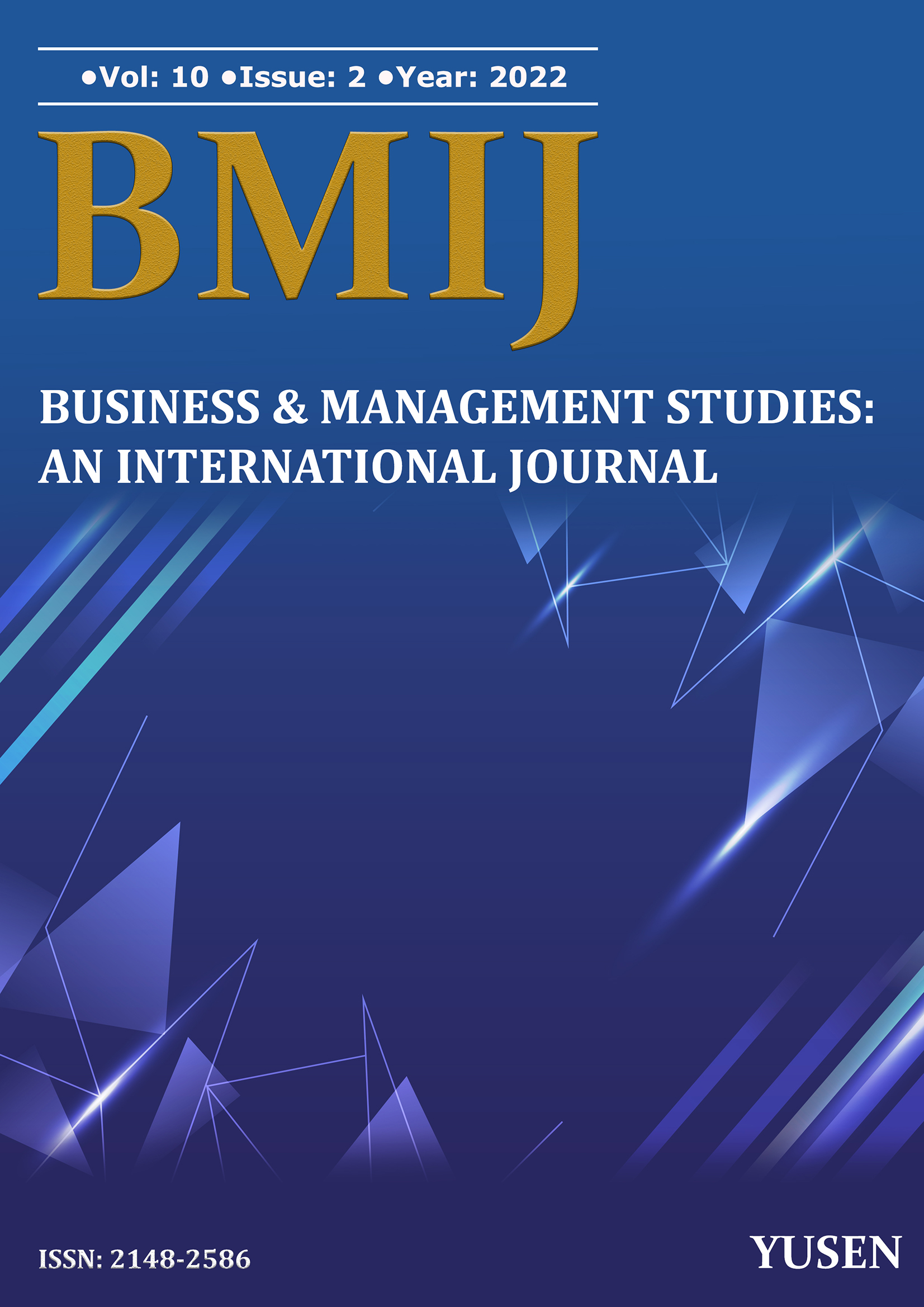
Yayınlanmış 25.06.2022
Anahtar Kelimeler
- Sustainability, Socio-Economic Sustainability, Multi-Attributive Border Approximation Area Comparison, Multi-Criteria Decision Making
- Sürdürülebilirlik, Sosyo-Ekonomik Sürdürülebilirlik, Multi-Attributive Border Approximation Area Comparison, Çok Kriterli Karar Verme
Nasıl Atıf Yapılır
Telif Hakkı (c) 2022 Rahmi BAKİ

Bu çalışma Creative Commons Attribution-NonCommercial-NoDerivatives 4.0 International License ile lisanslanmıştır.
Nasıl Atıf Yapılır
Öz
Sosyo-ekonomik sürdürülebilirlik (SES), bir kuruluşun veya bir ülkenin gelecek nesillerin ihtiyaçlarını karşılama yeteneklerini baltalamadan, çevresel kaynakların tükenmesini veya yok edilmesinin azaltılmasını ve ekonomik büyümenin sürdürülmesini sağlar. Bir ülkede SES'in sağlanması, çevreyi korurken uzun vadeli ekonomik ve sosyal kalkınmanın koşullarını şekillendirmeye yardımcı olur. Bu çalışma, çok kriterli bir yaklaşım uygulayarak Ekonomik İşbirliği ve Kalkınma Teşkilatı'na (OECD) üye 38 ülkenin SES performansına odaklanmakta ve bu performansları karşılaştırmaktadır. Bu araştırmanın amacı, gelişmiş ve gelişmekte olan ülkelerdeki SES hakkında çıkarımlarda bulunmak ve sürdürülebilir kalkınma hedefleri doğrultusunda değişimi teşvik etmektir. Rasyonel yönetim için yararlı ve güvenilir bir karar verme aracı olarak kabul edilen Multi-Attributive Border Approximation area Comparison (MABAC) tekniği uygulanmıştır. Uygulamada, dokuz kriter göz önünde bulundurularak 38 OECD ülkesinin performansını değerlendirmek için Birleşmiş Milletler Kalkınma Programı'ndan (UNDP) elde edilen sosyo-ekonomik performans göstergeleri incelenmiştir. Çalışmada, 38 ülke arasından en yüksek performans gösteren ülkelerin Kore ve Japonya, en düşük performans gösteren ülkelerin Kolombiya ve Meksika olduğunu tespit edilmiştir.
Referanslar
- Bhattacharya, H. (2020). Environmental and socio-economic sustainability in India: evidence from CO2 emission and economic inequality relationship. Journal of Environmental Economics and Policy, 9(1), 57-76.
- Biswas, T. K., & Das, M. C. (2019). Selection of commercially available electric vehicle using fuzzy AHP-MABAC. Journal of The Institution of Engineers (India): Series C, 100(3), 531-537.
- Boström, M. (2012). A missing pillar? Challenges in theorizing and practicing social sustainability: introduction to the special issue. Sustainability: Science, practice and policy, 8(1), 3-14.
- Büyüközkan, G., Mukul, E., & Kongar, E. (2021). Health tourism strategy selection via SWOT analysis and integrated hesitant fuzzy linguistic AHP-MABAC approach. Socio-Economic Planning Sciences, 74, 100929.
- Carli, R., Dotoli, M., & Pellegrino, R. (2018). Multi-criteria decision-making for sustainable metropolitan cities assessment. Journal of Environmental Management, 226, 46-61.
- Chakraborty, S., Dandge, S. S., & Agarwal, S. (2020). Non-traditional machining processes selection and evaluation: A rough multi-attributive border approximation area comparison approach. Computers & Industrial Engineering, 139, 106201.
- Chen, Y., & Zhang, D. (2020). Evaluation of city sustainability using multi-criteria decision-making considering interaction among criteria in Liaoning province China. Sustainable Cities and Society, 59, 102211.
- Gigović, L., Pamučar, D., Božanić, D., & Ljubojević, S. (2017). Application of the GIS-DANP-MABAC multi-criteria model for selecting the location of wind farms: A case study of Vojvodina, Serbia. Renewable Energy, 103, 501-521.
- Ivković, A. F., Ham, M., & Mijoč, J. (2014). Measuring objective well-being and sustainable development management. Journal of Knowledge Management, Economics and Information Technology, 4(2), 1-29.
- Luo, S. Z., & Xing, L. N. (2019). A hybrid decision making framework for personnel selection using BWM, MABAC and PROMETHEE. International Journal of Fuzzy Systems, 21(8), 2421-2434.
- Merlín-Uribe, Y., González-Esquivel, C. E., Contreras-Hernández, A., Zambrano, L., Moreno-Casasola, P., & Astier, M. (2013). Environmental and socio-economic sustainability of chinampas (raised beds) in Xochimilco, Mexico City. International Journal of Agricultural Sustainability, 11(3), 216-233.
- Okoye, P. U. (2016). Optimising the capacity of Nigeria construction sector for socio-economic sustainability. British Journal of Applied Science & Technology, 16(6), 1-16.
- Pamučar, D., & Božanić, D. (2019). Selection of a location for the development of multimodal logistics center: Application of single-valued neutrosophic MABAC model. Infinite Study. Operational Research in Engineering Sciences: Theory and Applications, 2(2), 55-71.
- Pamučar, D., & Ćirović, G. (2015). The selection of transport and handling resources in logistics centers using Multi-Attributive Border Approximation area Comparison (MABAC). Expert systems with applications, 42(6), 3016-3028.
- Pamučar, D., Stević, Ž., & Zavadskas, E. K. (2018). Integration of interval rough AHP and interval rough MABAC methods for evaluating university web pages. Applied Soft Computing, 67, 141-163.
- Santos, M., Radicchi, E., & Zagnoli, P. (2019). Port’s role as a determinant of cruise destination socio-economic sustainability. Sustainability, 11(17), 4542.
- Sawaengsak, W., Prasara-A, J., & Gheewala, S. H. (2021). Assessing the socio-economic sustainability of sugarcane harvesting in Thailand. Sugar Tech, 23(2), 263-277.
- Shan, J., & Khan, M. A. (2016). Implications of reverse innovation for socio-economic sustainability: A case study of Philips China. Sustainability, 8(6), 530-550.
- Skvarciany, V., Jurevičienė, D., & Volskytė, G. (2020). Assessment of sustainable socio-economic development in European Union countries. Sustainability, 12(5), 1986-2005.
- Smędzik-Ambroży, K., Guth, M., Stępień, S., & Brelik, A. (2019). The influence of the European Union’s common agricultural policy on the socio-economic sustainability of farms (the case of Poland). Sustainability, 11(24), 7173.
- Sonar, H. C., & Kulkarni, S. D. (2021). An integrated AHP-MABAC approach for electric vehicle selection. Research in Transportation Business & Management, 41, 100665.
- Starik, M., Stubbs, W., & Benn, S. (2016). Synthesising environmental and socio-economic sustainability models: A multi-level approach for advancing integrated sustainability research and practice. Australasian Journal of Environmental Management, 23(4), 402-425.
- Sun, R., Hu, J., Zhou, J., & Chen, X. (2018). A hesitant fuzzy linguistic projection-based MABAC method for patients’ prioritization. International Journal of Fuzzy Systems, 20(7), 2144-2160.
- United Nations Development Programme (UNDP) (2022). Human Development Data Center. Retrieved from: https://hdr.undp.org/en/data
- Wei, G., Wei, C., Wu, J., & Wang, H. (2019). Supplier selection of medical consumption products with a probabilistic linguistic MABAC method. International Journal of Environmental Research and Public Health, 16(24), 5082.
- Xue, Y. X., You, J. X., Lai, X. D., & Liu, H. C. (2016). An interval-valued intuitionistic fuzzy MABAC approach for material selection with incomplete weight information. Applied Soft Computing, 38, 703-713.



